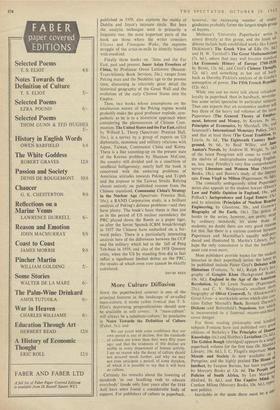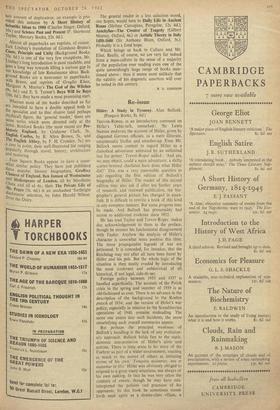More Culture Diffusion
SINCE the paperbacked cataract is one of the principal features in the landscape of so-called mass-culture, it seems rather ironical that T. S. Eliot's depressing prognostications should now be available in soft covers: 'A "mass-culture" will always be a substitute-culture,' he proclaims in Notes Towards the Definition of Culture (Faber, 5s.); and
We can assert with some confidence that our own period is one of decline; that the standards of culture are lower than they were fifty years ago; and that the evidences of this decline are visible in every department of human activity. I see no reason why the decay of culture should not proceed much further, and why we may not even anticipate a period, of some duration, of which it is possible to say that it will have no culture.
Certainly his remarks about the lowering of standards 'in our headlong rush to educate everybody' (made only four years after the 1944 Act) have since found a considerable body of support. For publishers of culture in paperback,
E SPECTATOR. OCTOBER 26. 1 9 6 2 however, the increasing number of under- graduates probably forms the largest single group of buyers. Methuen's 'University Paperbacks' series is aimed directly at this group, and the latest ad- ditions include both established works like Lowes Dickinson's The Greek View of Life (9s. 6d.) and H. W. Turnbull's The Great Mathematicians (7s. 6d.), others that may well become standard (An Economic History of Europe 17604939' by Birnie, 12s. 6d., and Creel's Chinese Thought' 12s. 6d.), and something as hot out of hard- back as Dorothy Pickles's analysis of de Gaulle 5 assumption of power, The Fifth French Republic (12s. 6d.).
While one can no more talk about colophon'
loyalty in paperback than in hardback, neverthe- less some series specialise in particular subjects; Thus one expects that an economics student Will buy three of the heavy red volumes of the latest Papermacs (The General Theory of En1PI°Y,' ment, Interest and Money, by Keynes, 8s. 6°._; Principles of Economics, by Marshall, 18s., all Scammell's International Monetary Policy, and that at least three (The Great Tradition, by Leavis, 9s. 6d., The Eighteenth Century Back- ground, 9s. 6d., by Basil Willey, and We, Austen's Novels, by Andrew H. Wright, 7s. 6c,/ of the latest Peregrines will come to roost 011 the shelves of undergraduates reading English; so, too, may Priestley's very fine comprehensive survey Literature and Western Man (Mercury Books, 18s.), and Bowra's study of the literary epic From Virgil to Milton (Papermacs, 9s. 6d The comically ambiguously titled Papermac,s series also appeals to the student lawyer (DiceYcs Law and Public Opinion in England, 18s., and , Pollock's Jurisprudence and Legal Essays, l5s4 and to scientists (Principles of Nuclear Reactor Engineering, by Glasstone, 30s., and Gamow s, Biography of the Earth, 16s.). The prices 01 books in the series, however, are pretty steel; by ordinary standards, let alone those students; no doubt there are very good reasons for this, but there is a curious contrast betwee° Papermacs and. Macmillan's equally well-pro,: duced and illustrated St. Martin's Library. Pe': haps the only consolation is that the hardbacK must cost even more. Most publishers provide books for the student historian in their paperback series: the latest t0 be published include Pieter Geyl's Debates with Historians (Fontana, 7s. 6d.), Ralph Fox's hicl-) graphy of Genghis Khan (Background Wks' 10s. 6d.), England in the Age of the Americas Revolution, by Sir Lewis Namier (Papermacs: 25s.). and C. V. Wedgwood's excellent shot
,`
biography of Oliver Cromwell, 5s. (Duckworth! Great Lives—a worthwhile series which also coa, tains Esther Meynell's Bach, Bernard Darwin s Dickens and Butterfield's Napoleon, but which is incarcerated in a funereal mauve-and-black cover design). For those reading philosophy and kindred subjects Fontana have, just published very &°°d editions of Berkeley's The Principles of 1111," Knowledge (6s.) and Hobbes's Leviathan (is. 6 L' The Golden Bough (abridged) appears in a sing]; paperback volume for the first time (St. Martin s Library, 10s. 6d.), J. C. Flugel's important Man' Morals and Society is now available as tlf Peregrine, and the highly praised The House °A Intellect, by Jacques Barzun, has been reprinte:i by Mercury Books at 12s. 6d. The People and Policies of South Africa, by Leo Marclokv (Oxford, 8s. 6d.), and The Captive Mind' ,), Czeslaw Milosz (Mercury Books, 10s. 6d.), rep',.`" sent politics.
Inevitably in the spate there must be a °et
lain amount of duplication: an example is pro- vided this autumn by A Short History of • Scientific Ideas to 1900 (Charles Singer, Oxford, 10s.) and Science Past and Present (F. Sherwood
• Taylor, Mercury Books, 12s. 6d.).
Almost all paperbacks are reprints, of course: - Tack Lindsay's translation of Giordano Bruno 's Cause, Principle and Unity (Background Books, 108. 6(0 is one of the very few exceptions. Mr. Lindsay's long introduction is most readable, and goes a long way towards filling a curious gap in our knowledge of late Renaissance ideas. Back- ground Books are a newcomer to paperbacks: with Bruno, and reprints of Genghis Khan, Margaret A. Murray's The God of the Witches (9s. 6d.) and E. S. Turner's Boys Will be Boys (10s. 6d.), they have made a most promising start. Whereas most of the books described so far are intended to have a double appeal both to the specialist and to that elusive (and perhaps Mythical) figure, the `general reader,' there are some series which seem directed only at the latter. 13atsford Books (the most recent are Pre- historic England, by Grahame Clark, 5s., English Castles, by R. Allen Brown, 5s., and The English Abbey, by F. H. Crossley, 5s.) are -a case in point, their well-illustrated list ranging Popularly through travel, history, architecture and motoring. Four Square Books appear to have a some- What similar policy. They have just published three popular literary biographies, Geoffrey Chaucer of England, Ben Jonson of Westminster and Shakespeare of London, all by Marchette Chute and all at 4s..; their The Private Life of eePys (3s. 6d.) is an unabashed `forthright u,Iselosures' selection, by John Harold Wilson, from the Diary. The general reader in a less salacious mood, one hopes, would turn to Daily Life in Ancient Rome (Jeriime Carcopino, Peregrine, 12s. 6d.), Aeschylus-The Creator of Tragedy (Gilbert Murray, Oxford, 6s.) or Artistic Theory in Italy 1450-1600 (Sir Anthony Blunt, Oxford, 5s.). Probably it is a fond hope.
Which brings us back to Culture and Mr. Eliot. Really, of course, we are very far indeed from a mass-culture in the sense of a majority of the population ever reading even one of the quite astonishingly large range of books men- tioned above: thus it seems most unlikely that the validity of his dogmatic assertion will ever be tested in this century.
B. S. JOHNSON















































 Previous page
Previous page